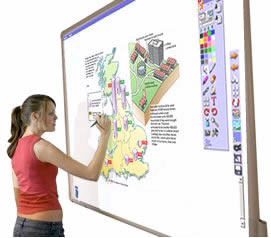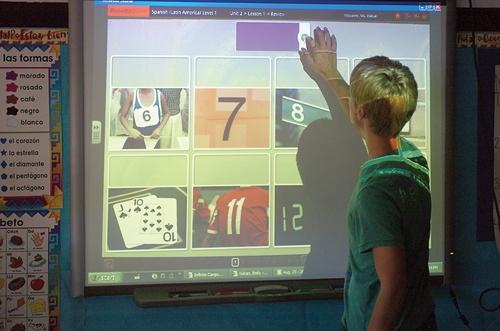IWBs
have gone from an unknown technology to a key educational tool in a short
period of time. Yet although they are widely used, there are some useful
features that many teachers are unaware of. In this short article, we will
reveal some of the interesting ways you can use your IWB.
Archiving Lessons
Most of us will have "fond" memories of desperately trying to
copy a teacher's notes before they can delete them while also trying to pay
attention to what's being said. It's a hard task. IWBs offer a simple solution.

While the IWB is a great tool for displaying interactive content and prepared
lessons, it can also be used to record notes from lessons. Of course, this
depends on the model of IWB that you have, but most IWB manufacturers add a
record function to their products.
If you start with a blank presentation, you will be able to record the notes
that you make during the lesson. After the lesson has ended, you can share the
file with your students. This allows them to stop worrying about copying your
notes. Instead, they can pay more attention to what you're saying!
You can also share the file on your school's website, by email, or even on a
publicly accessible site such as SlideShare. Of course, you are also at liberty
to reuse the materials in a future lesson.
Over time, you will have a tangible record of the effectiveness of different
methods of introducing a concept, or different approaches to discussion.
Interactive Quizzes
Interactive quizzes are a great way to drive engagement. They apply the
principle of "gamification," which has proven itself to be more than
a mere buzzword. Projects such as the Khan Academy prove that the use of
frequent quizzes increases engagement, understanding, and retention.

Creating your own interactive quizzes is a little more taxing than creating
simple presentations, but there is software that makes the task easier.
You will also require input devices for the students to respond to the quiz
questions, and a controller so you can control the quiz. There are several
different input devices which could be used, but the simple "clicker"
or Student Response System is the best.
The teacher has a similar device that displays questions on the board. Students
use their clickers to rapidly select from several answers (multiple choices).
When the teacher moves to the next question, any students who did not reply
lose the opportunity to do so (the quiz rewards the ability to quickly respond
and recall the information).
At the end of the quiz, you can use graphs to analyze the results, and
individual students can review the questions they did not understand.
IWBs are very useful devices, and educators continue to find new ways to use
them. It's worth investing a little time to enhance your classes with the
latest techniques. The payoff is better results and a reduced workload.
Previous:3 Excellent Interactive Board Activities For Teaching Math Concepts
Next:Why Investing in IWBs for Schools Will Result in Long-Term Financial Savings

